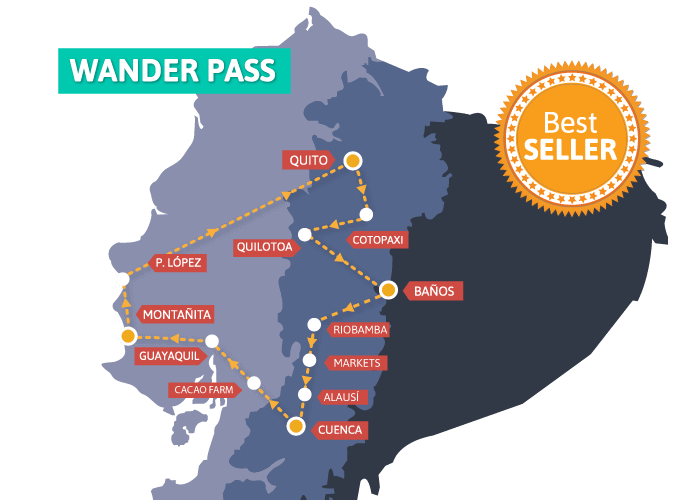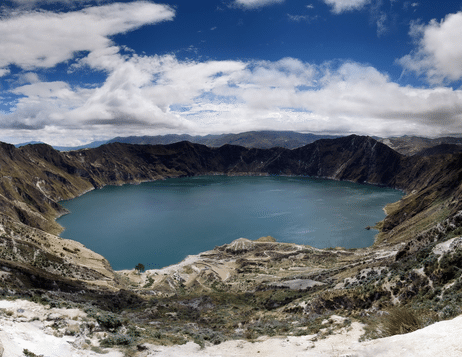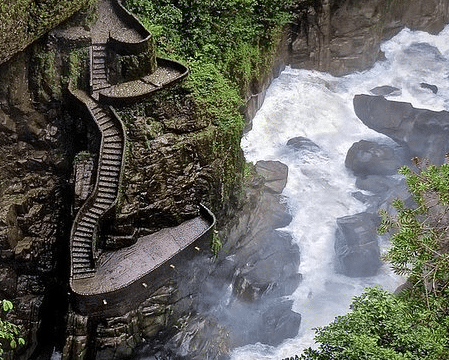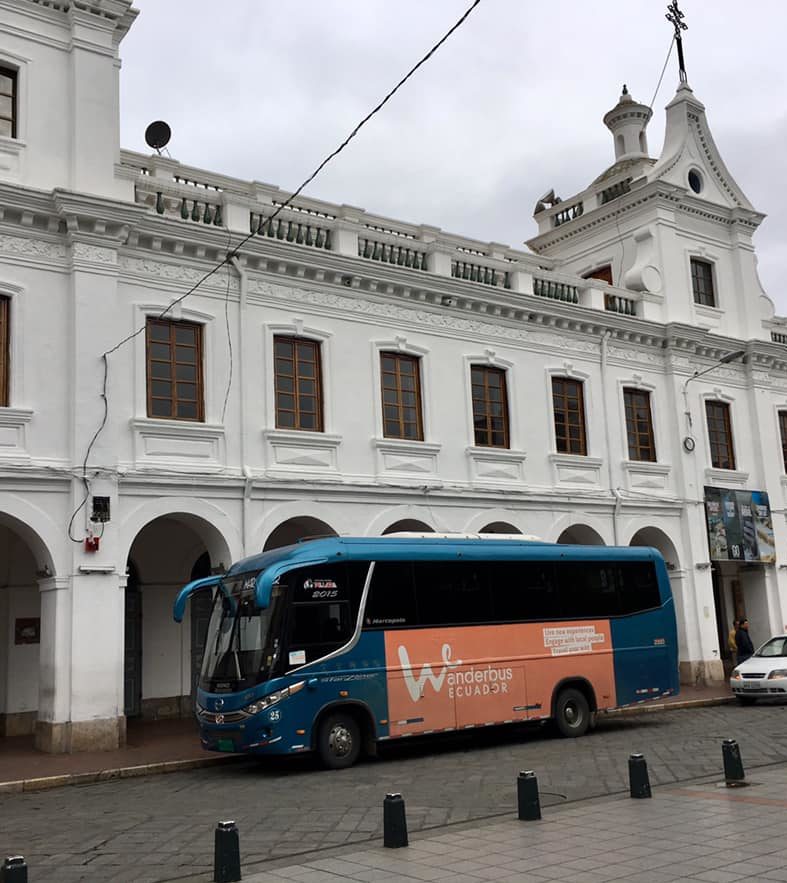My Ecuador journey on the Wanderbus!

By Julia Rux
Ecuador has so many distinct regions — the Andes with volcanoes, the Amazon/Oriente, the Coast, and the Galapagos — that many expats never get a chance to thoroughly explore.
I was intrigued by a new model for travel called Wanderbus that offers the option of hopping on and hopping off a nice big bus as it journeys around the country in a clockwise circle. I wanted to know more about my adopted country without the hassles of driving or bus terminals, so Wanderbus Ecuador seemed the perfect way to go.
circle. I wanted to know more about my adopted country without the hassles of driving or bus terminals, so Wanderbus Ecuador seemed the perfect way to go.
This is how Wanderbus works: You can hop on in any of the major cities, and then hop off at any designated stop, stay as long as you want, and know that in two or three days another bus will come through to take you to the next destination. A nice aspect of the Wanderbus is the guide on each bus, who welcomes you, gives you a water bottle and unlimited filtered refills snacks and provides enthusiastic information, in English and Spanish, about all the cultural and historic areas you are encountering. There are regular bathroom and meal stops. Each traveler pays for her or his own meals.
My journey began in Quito and ended in Cuenca. My ticket was the Colibri Pass and cost me $149. I boarded at 6 a.m. in Plaza Foch along with 11 others, half young backpackers and half retirees like me. Our first stop was at a Tambillo Dairy Farm called La Victoria. We enjoyed a great breakfast and had the chance to milk a cow. Our guide, Pamela, had us do ice-breaking games so that we were all great traveling friends from then on.

Our next stop was the Cotopaxi National Park. The translation from Quichua of Cotopaxi,by the way, is “Next to the Moon”.
We had a lovely walk around the Limpio Pungo Laguna, or “Open Door” Lagoon. Pamela pointed out the medicinal plants and unique properties of the soft green ground-cover, “alfombrillo” or carpet, which retains the water of the Paramo. She also recounted the legend of competition between the volcanoes Cotopaxi and Chimborazo for the affection of the Mama Turunguhua volcano. Chimborazo prevailed and they have lived on happily ever after.
In addition, we had the good fortune to see a herd of wild horses drinking at the lagoon just as the clouds parted to show the snowy top of Cotopaxi.

Quilatoa Crater Lake
We passed through beautiful Andean valleys and mountainside villages on our way to lunch in the town of Pujilli, famous for the dancers who celebrate the Corpus Christi festivities in September. Lunch was in a popular local restaurant, a typical almuerzo of soup, a main course of either shrimp, chicken, beef or veggies, rice, potatoes, and a juice and dessert.
Our next stop was in the Quilatoa Crater village. The Quilatoa volcano erupted many years ago and created amazing craters and barrancos for miles around. Hiking into and around the crater down to the Caldera lake is a popular activity for tourists. Kayaking on the lake, and riding up on horseback are other options.
As this was my first hop off, I made reservations for three nights at the Black Sheep Inn about 20 minutes away. The Inn is a beautiful, rustic, but upscale eco-friendly place. They arranged for a tour to a cheese factory and a hike through the edge of a cloud forest. I enjoyed the hot tub, steam room and little wood burning stove in my room. I could have spent more relaxing days there but it was time to move on.

Overlook of a waterfall in Baños de Ambato.
On the third day, Wanderbus picked us up at Quilatoa at 3:30 pm. With my 15 new traveling companions and our guide, Hayde, we headed to Baños-Ambato. I stayed at the Posada el Arte, owned by Americans Marcia and Jim, located in town near the waterfall and hot baths. There, I spent two days enjoying the El Salado Hot Springs and going on a tour up the Palate River to an old fashioned restaurant that serves duck cooked in a clay container. Extreme sports are very popular in Baños.
At 6:40 a.m. the third day a small group of six passengers met the Wanderbus in front of the Baños Basilica and began our journey toward Cuenca. We had breakfast in the market of Riobamba. This old colonial town is known for the 300-year-old houses with unique and lovely balconies. Our next stop for photos and bathroom visits was in Colta. Paul, our guide, told us why the Spanish built this church, the first in Ecuador, in this spot. Many Spaniards came from Extremadura Spain, and they were dying of thirst when they came upon the Colta Lagoon with life-saving fresh water for themselves and their horses, so they named the church in honor of the Virgin of Balbanera, from their hometown.

Sunday mornings the Wanderbus picks up passengers next to the New Cathedral across from Parque Calderón in Cuenca. Credit: Susan March (wandering around on an early Sunday morning).
The highlight of this day was a two-hour stop inside the National Park Sangay, not far from the Chimborazo volcano. We hiked to visit the sacred lagoons. Our guide, Paul, claims the area is magic. It was beautiful, if cold, windy, and at about 11,000 feet. We were rescued from the elements by three indigenous women who prepared a sumptuous lunch of trout, choclo, potatoes, bananas, and hot tea. We also saw cowboys on horseback, “chagras” herding their vociferous cows across the ridge.
The final leg of our journey passed by Alausi and the famous Devil’s Nose Train, as no one wanted to hop off there. We arrived in Cuenca to Parque Calderon at 7:45 p.m.
For me, Wanderbus Ecuador seemed to be the perfect way to travel. In the future, I will happily hop on the bus which goes to Guayaquil continuing the loop around Ecuador, stopping in Montanita on the coast, and then back up to Quito.
For more information about Wanderbus Ecuador, go to the website, write info@wanderbusecuador.com or call +593-98-691-9193.
________________________
Julia Rux happily retired to Cuenca in 2015.  She originally fell in love with Ecuador on a Fulbright Teaching Fellowship at the University of Azuay (UDA). Having taught Developmental Psychology and Anthropology for Georgia State made the richness of Ecuador’s indigenous groups a perfect fit. If you’d like to chat with Julia email: juliaecuador260@gmail.com
She originally fell in love with Ecuador on a Fulbright Teaching Fellowship at the University of Azuay (UDA). Having taught Developmental Psychology and Anthropology for Georgia State made the richness of Ecuador’s indigenous groups a perfect fit. If you’d like to chat with Julia email: juliaecuador260@gmail.com






















